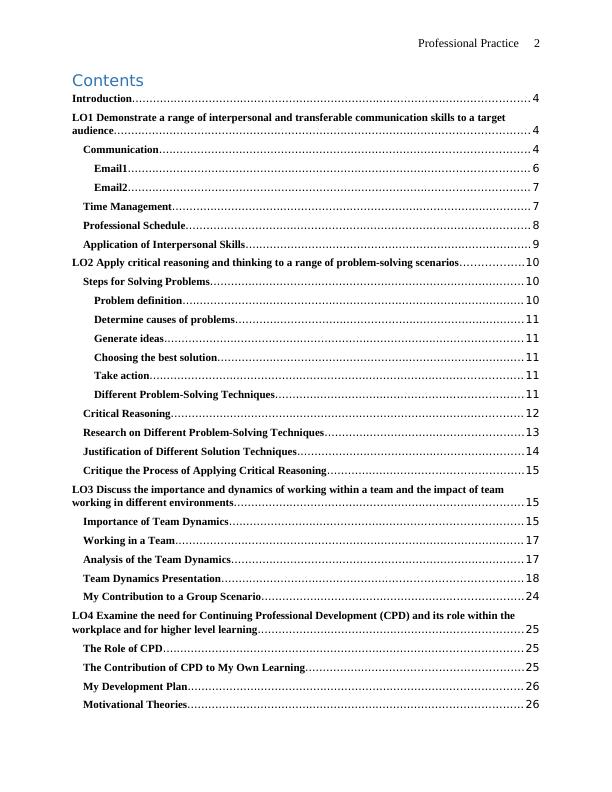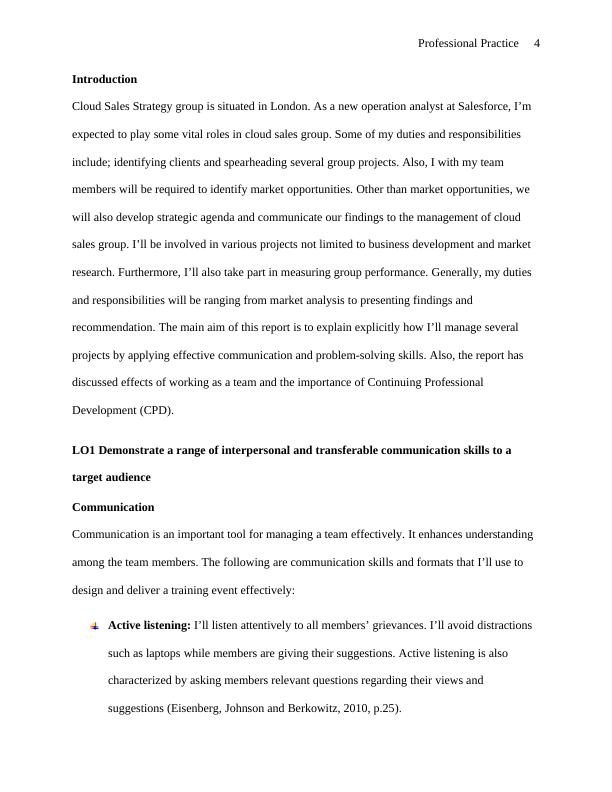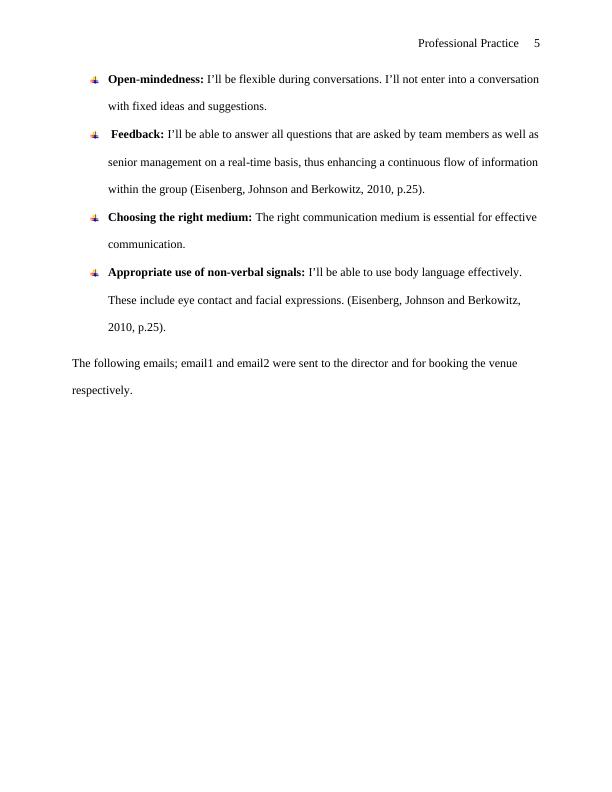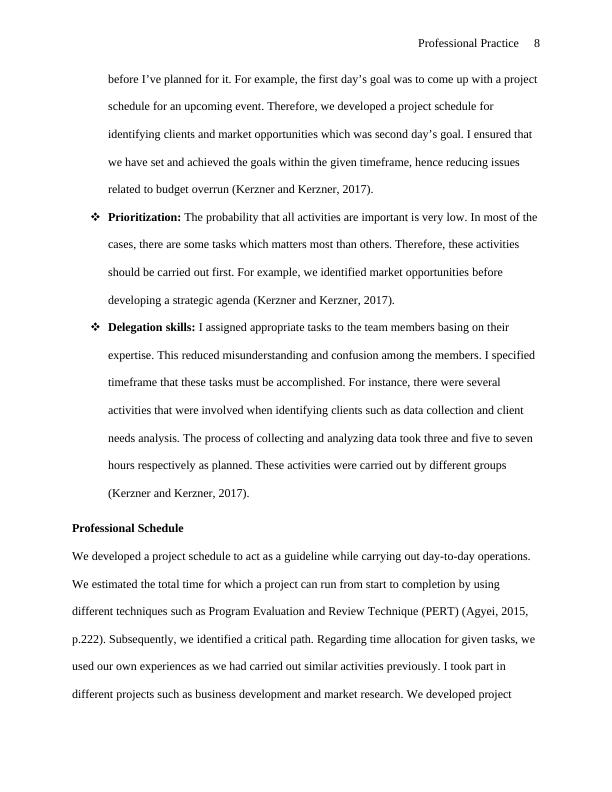Professional Practice
Added on 2022-11-25
38 Pages6476 Words383 Views
Professional Practice 1
PROFESSIONAL PRACTICE
By
(Name)
(Course)
(Professor’s Name)
(Institution)
(State)
(Date
PROFESSIONAL PRACTICE
By
(Name)
(Course)
(Professor’s Name)
(Institution)
(State)
(Date

Professional Practice 2
Contents
Introduction.................................................................................................................. 4
LO1 Demonstrate a range of interpersonal and transferable communication skills to a target
audience....................................................................................................................... 4
Communication.......................................................................................................... 4
Email1................................................................................................................... 6
Email2................................................................................................................... 7
Time Management....................................................................................................... 7
Professional Schedule................................................................................................... 8
Application of Interpersonal Skills.................................................................................. 9
LO2 Apply critical reasoning and thinking to a range of problem-solving scenarios..................10
Steps for Solving Problems.......................................................................................... 10
Problem definition.................................................................................................. 10
Determine causes of problems...................................................................................11
Generate ideas....................................................................................................... 11
Choosing the best solution........................................................................................ 11
Take action........................................................................................................... 11
Different Problem-Solving Techniques.......................................................................11
Critical Reasoning..................................................................................................... 12
Research on Different Problem-Solving Techniques.........................................................13
Justification of Different Solution Techniques.................................................................14
Critique the Process of Applying Critical Reasoning........................................................15
LO3 Discuss the importance and dynamics of working within a team and the impact of team
working in different environments...................................................................................15
Importance of Team Dynamics.................................................................................... 15
Working in a Team.................................................................................................... 17
Analysis of the Team Dynamics.................................................................................... 17
Team Dynamics Presentation...................................................................................... 18
My Contribution to a Group Scenario...........................................................................24
LO4 Examine the need for Continuing Professional Development (CPD) and its role within the
workplace and for higher level learning............................................................................ 25
The Role of CPD....................................................................................................... 25
The Contribution of CPD to My Own Learning..............................................................25
My Development Plan................................................................................................ 26
Motivational Theories................................................................................................ 26
Contents
Introduction.................................................................................................................. 4
LO1 Demonstrate a range of interpersonal and transferable communication skills to a target
audience....................................................................................................................... 4
Communication.......................................................................................................... 4
Email1................................................................................................................... 6
Email2................................................................................................................... 7
Time Management....................................................................................................... 7
Professional Schedule................................................................................................... 8
Application of Interpersonal Skills.................................................................................. 9
LO2 Apply critical reasoning and thinking to a range of problem-solving scenarios..................10
Steps for Solving Problems.......................................................................................... 10
Problem definition.................................................................................................. 10
Determine causes of problems...................................................................................11
Generate ideas....................................................................................................... 11
Choosing the best solution........................................................................................ 11
Take action........................................................................................................... 11
Different Problem-Solving Techniques.......................................................................11
Critical Reasoning..................................................................................................... 12
Research on Different Problem-Solving Techniques.........................................................13
Justification of Different Solution Techniques.................................................................14
Critique the Process of Applying Critical Reasoning........................................................15
LO3 Discuss the importance and dynamics of working within a team and the impact of team
working in different environments...................................................................................15
Importance of Team Dynamics.................................................................................... 15
Working in a Team.................................................................................................... 17
Analysis of the Team Dynamics.................................................................................... 17
Team Dynamics Presentation...................................................................................... 18
My Contribution to a Group Scenario...........................................................................24
LO4 Examine the need for Continuing Professional Development (CPD) and its role within the
workplace and for higher level learning............................................................................ 25
The Role of CPD....................................................................................................... 25
The Contribution of CPD to My Own Learning..............................................................25
My Development Plan................................................................................................ 26
Motivational Theories................................................................................................ 26

Professional Practice 3
Vroom’s Expectancy theory..................................................................................... 26
Porter and Lawler’s expectancy theory......................................................................27
McClelland’s need theory........................................................................................ 27
Difference between Vroom’s Expectancy and Porter and Lawler’s Expectancy Theories......27
Evidence Criteria for Measuring CPD Effectiveness.........................................................28
Conclusion.................................................................................................................. 28
References.................................................................................................................. 30
Vroom’s Expectancy theory..................................................................................... 26
Porter and Lawler’s expectancy theory......................................................................27
McClelland’s need theory........................................................................................ 27
Difference between Vroom’s Expectancy and Porter and Lawler’s Expectancy Theories......27
Evidence Criteria for Measuring CPD Effectiveness.........................................................28
Conclusion.................................................................................................................. 28
References.................................................................................................................. 30

Professional Practice 4
Introduction
Cloud Sales Strategy group is situated in London. As a new operation analyst at Salesforce, I’m
expected to play some vital roles in cloud sales group. Some of my duties and responsibilities
include; identifying clients and spearheading several group projects. Also, I with my team
members will be required to identify market opportunities. Other than market opportunities, we
will also develop strategic agenda and communicate our findings to the management of cloud
sales group. I’ll be involved in various projects not limited to business development and market
research. Furthermore, I’ll also take part in measuring group performance. Generally, my duties
and responsibilities will be ranging from market analysis to presenting findings and
recommendation. The main aim of this report is to explain explicitly how I’ll manage several
projects by applying effective communication and problem-solving skills. Also, the report has
discussed effects of working as a team and the importance of Continuing Professional
Development (CPD).
LO1 Demonstrate a range of interpersonal and transferable communication skills to a
target audience
Communication
Communication is an important tool for managing a team effectively. It enhances understanding
among the team members. The following are communication skills and formats that I’ll use to
design and deliver a training event effectively:
Active listening: I’ll listen attentively to all members’ grievances. I’ll avoid distractions
such as laptops while members are giving their suggestions. Active listening is also
characterized by asking members relevant questions regarding their views and
suggestions (Eisenberg, Johnson and Berkowitz, 2010, p.25).
Introduction
Cloud Sales Strategy group is situated in London. As a new operation analyst at Salesforce, I’m
expected to play some vital roles in cloud sales group. Some of my duties and responsibilities
include; identifying clients and spearheading several group projects. Also, I with my team
members will be required to identify market opportunities. Other than market opportunities, we
will also develop strategic agenda and communicate our findings to the management of cloud
sales group. I’ll be involved in various projects not limited to business development and market
research. Furthermore, I’ll also take part in measuring group performance. Generally, my duties
and responsibilities will be ranging from market analysis to presenting findings and
recommendation. The main aim of this report is to explain explicitly how I’ll manage several
projects by applying effective communication and problem-solving skills. Also, the report has
discussed effects of working as a team and the importance of Continuing Professional
Development (CPD).
LO1 Demonstrate a range of interpersonal and transferable communication skills to a
target audience
Communication
Communication is an important tool for managing a team effectively. It enhances understanding
among the team members. The following are communication skills and formats that I’ll use to
design and deliver a training event effectively:
Active listening: I’ll listen attentively to all members’ grievances. I’ll avoid distractions
such as laptops while members are giving their suggestions. Active listening is also
characterized by asking members relevant questions regarding their views and
suggestions (Eisenberg, Johnson and Berkowitz, 2010, p.25).

Professional Practice 5
Open-mindedness: I’ll be flexible during conversations. I’ll not enter into a conversation
with fixed ideas and suggestions.
Feedback: I’ll be able to answer all questions that are asked by team members as well as
senior management on a real-time basis, thus enhancing a continuous flow of information
within the group (Eisenberg, Johnson and Berkowitz, 2010, p.25).
Choosing the right medium: The right communication medium is essential for effective
communication.
Appropriate use of non-verbal signals: I’ll be able to use body language effectively.
These include eye contact and facial expressions. (Eisenberg, Johnson and Berkowitz,
2010, p.25).
The following emails; email1 and email2 were sent to the director and for booking the venue
respectively.
Open-mindedness: I’ll be flexible during conversations. I’ll not enter into a conversation
with fixed ideas and suggestions.
Feedback: I’ll be able to answer all questions that are asked by team members as well as
senior management on a real-time basis, thus enhancing a continuous flow of information
within the group (Eisenberg, Johnson and Berkowitz, 2010, p.25).
Choosing the right medium: The right communication medium is essential for effective
communication.
Appropriate use of non-verbal signals: I’ll be able to use body language effectively.
These include eye contact and facial expressions. (Eisenberg, Johnson and Berkowitz,
2010, p.25).
The following emails; email1 and email2 were sent to the director and for booking the venue
respectively.

Professional Practice 6
Email1
Email1

Professional Practice 7
Email2
Time Management
To manage time effectively, I ensure that we’ve carried out specific tasks within a given
timeframe. The following are some of the skills that I’ve used to plan for upcoming events:
Goal setting: Time management cannot be separated from goal setting, hence
indispensable. Goal setting is one of the key considerations for effective time
management. Therefore, I try to understand the desired outcome of a particular event
Email2
Time Management
To manage time effectively, I ensure that we’ve carried out specific tasks within a given
timeframe. The following are some of the skills that I’ve used to plan for upcoming events:
Goal setting: Time management cannot be separated from goal setting, hence
indispensable. Goal setting is one of the key considerations for effective time
management. Therefore, I try to understand the desired outcome of a particular event

Professional Practice 8
before I’ve planned for it. For example, the first day’s goal was to come up with a project
schedule for an upcoming event. Therefore, we developed a project schedule for
identifying clients and market opportunities which was second day’s goal. I ensured that
we have set and achieved the goals within the given timeframe, hence reducing issues
related to budget overrun (Kerzner and Kerzner, 2017).
Prioritization: The probability that all activities are important is very low. In most of the
cases, there are some tasks which matters most than others. Therefore, these activities
should be carried out first. For example, we identified market opportunities before
developing a strategic agenda (Kerzner and Kerzner, 2017).
Delegation skills: I assigned appropriate tasks to the team members basing on their
expertise. This reduced misunderstanding and confusion among the members. I specified
timeframe that these tasks must be accomplished. For instance, there were several
activities that were involved when identifying clients such as data collection and client
needs analysis. The process of collecting and analyzing data took three and five to seven
hours respectively as planned. These activities were carried out by different groups
(Kerzner and Kerzner, 2017).
Professional Schedule
We developed a project schedule to act as a guideline while carrying out day-to-day operations.
We estimated the total time for which a project can run from start to completion by using
different techniques such as Program Evaluation and Review Technique (PERT) (Agyei, 2015,
p.222). Subsequently, we identified a critical path. Regarding time allocation for given tasks, we
used our own experiences as we had carried out similar activities previously. I took part in
different projects such as business development and market research. We developed project
before I’ve planned for it. For example, the first day’s goal was to come up with a project
schedule for an upcoming event. Therefore, we developed a project schedule for
identifying clients and market opportunities which was second day’s goal. I ensured that
we have set and achieved the goals within the given timeframe, hence reducing issues
related to budget overrun (Kerzner and Kerzner, 2017).
Prioritization: The probability that all activities are important is very low. In most of the
cases, there are some tasks which matters most than others. Therefore, these activities
should be carried out first. For example, we identified market opportunities before
developing a strategic agenda (Kerzner and Kerzner, 2017).
Delegation skills: I assigned appropriate tasks to the team members basing on their
expertise. This reduced misunderstanding and confusion among the members. I specified
timeframe that these tasks must be accomplished. For instance, there were several
activities that were involved when identifying clients such as data collection and client
needs analysis. The process of collecting and analyzing data took three and five to seven
hours respectively as planned. These activities were carried out by different groups
(Kerzner and Kerzner, 2017).
Professional Schedule
We developed a project schedule to act as a guideline while carrying out day-to-day operations.
We estimated the total time for which a project can run from start to completion by using
different techniques such as Program Evaluation and Review Technique (PERT) (Agyei, 2015,
p.222). Subsequently, we identified a critical path. Regarding time allocation for given tasks, we
used our own experiences as we had carried out similar activities previously. I took part in
different projects such as business development and market research. We developed project

End of preview
Want to access all the pages? Upload your documents or become a member.
Related Documents
Importance of Team Dynamics in Working Environmentlg...
|17
|4419
|98
Report on Continuing Professional Development (CPD)lg...
|18
|4022
|29
Professional practices : Time management skilllg...
|71
|20231
|75
Business Communication and Team Development: A Reflection on Interpersonal and Intrapersonal Dynamicslg...
|11
|2933
|182
Professional Practice Assignment Solutionlg...
|18
|5163
|175
Professional practice international school of management and technology PDFlg...
|32
|7806
|36